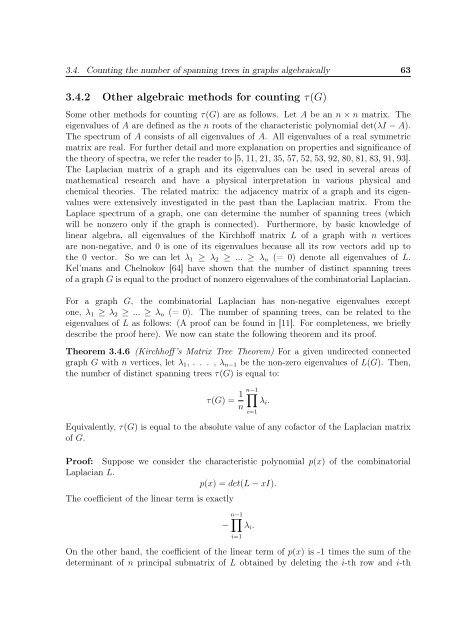enumeration of the number of spanning trees in some ... - Toubkal
enumeration of the number of spanning trees in some ... - Toubkal
enumeration of the number of spanning trees in some ... - Toubkal
You also want an ePaper? Increase the reach of your titles
YUMPU automatically turns print PDFs into web optimized ePapers that Google loves.
3.4. Count<strong>in</strong>g <strong>the</strong> <strong>number</strong> <strong>of</strong> <strong>spann<strong>in</strong>g</strong> <strong>trees</strong> <strong>in</strong> graphs algebraically 633.4.2 O<strong>the</strong>r algebraic methods for count<strong>in</strong>g τ(G)Some o<strong>the</strong>r methods for count<strong>in</strong>g τ(G) are as follows. Let A be an n × n matrix. Theeigenvalues <strong>of</strong> A are def<strong>in</strong>ed as <strong>the</strong> n roots <strong>of</strong> <strong>the</strong> characteristic polynomial det(λI − A).The spectrum <strong>of</strong> A consists <strong>of</strong> all eigenvalues <strong>of</strong> A. All eigenvalues <strong>of</strong> a real symmetricmatrix are real. For fur<strong>the</strong>r detail and more explanation on properties and significance <strong>of</strong><strong>the</strong> <strong>the</strong>ory <strong>of</strong> spectra, we refer <strong>the</strong> reader to [5, 11, 21, 35, 57, 52, 53, 92, 80, 81, 83, 91, 93].The Laplacian matrix <strong>of</strong> a graph and its eigenvalues can be used <strong>in</strong> several areas <strong>of</strong>ma<strong>the</strong>matical research and have a physical <strong>in</strong>terpretation <strong>in</strong> various physical andchemical <strong>the</strong>ories. The related matrix: <strong>the</strong> adjacency matrix <strong>of</strong> a graph and its eigenvalueswere extensively <strong>in</strong>vestigated <strong>in</strong> <strong>the</strong> past than <strong>the</strong> Laplacian matrix. From <strong>the</strong>Laplace spectrum <strong>of</strong> a graph, one can determ<strong>in</strong>e <strong>the</strong> <strong>number</strong> <strong>of</strong> <strong>spann<strong>in</strong>g</strong> <strong>trees</strong> (whichwill be nonzero only if <strong>the</strong> graph is connected). Fur<strong>the</strong>rmore, by basic knowledge <strong>of</strong>l<strong>in</strong>ear algebra, all eigenvalues <strong>of</strong> <strong>the</strong> Kirchh<strong>of</strong>f matrix L <strong>of</strong> a graph with n verticesare non-negative, and 0 is one <strong>of</strong> its eigenvalues because all its row vectors add up to<strong>the</strong> 0 vector. So we can let λ 1 ≥ λ 2 ≥ ... ≥ λ n (= 0) denote all eigenvalues <strong>of</strong> L.Kel’mans and Chelnokov [64] have shown that <strong>the</strong> <strong>number</strong> <strong>of</strong> dist<strong>in</strong>ct <strong>spann<strong>in</strong>g</strong> <strong>trees</strong><strong>of</strong> a graph G is equal to <strong>the</strong> product <strong>of</strong> nonzero eigenvalues <strong>of</strong> <strong>the</strong> comb<strong>in</strong>atorial Laplacian.For a graph G, <strong>the</strong> comb<strong>in</strong>atorial Laplacian has non-negative eigenvalues exceptone, λ 1 ≥ λ 2 ≥ ... ≥ λ n (= 0). The <strong>number</strong> <strong>of</strong> <strong>spann<strong>in</strong>g</strong> <strong>trees</strong>, can be related to <strong>the</strong>eigenvalues <strong>of</strong> L as follows: (A pro<strong>of</strong> can be found <strong>in</strong> [11]. For completeness, we brieflydescribe <strong>the</strong> pro<strong>of</strong> here). We now can state <strong>the</strong> follow<strong>in</strong>g <strong>the</strong>orem and its pro<strong>of</strong>.Theorem 3.4.6 (Kirchh<strong>of</strong>f’s Matrix Tree Theorem) For a given undirected connectedgraph G with n vertices, let λ 1 , . . . , λ n−1 be <strong>the</strong> non-zero eigenvalues <strong>of</strong> L(G). Then,<strong>the</strong> <strong>number</strong> <strong>of</strong> dist<strong>in</strong>ct <strong>spann<strong>in</strong>g</strong> <strong>trees</strong> τ(G) is equal to:τ(G) = 1 n−1∏λ i .nEquivalently, τ(G) is equal to <strong>the</strong> absolute value <strong>of</strong> any c<strong>of</strong>actor <strong>of</strong> <strong>the</strong> Laplacian matrix<strong>of</strong> G.Pro<strong>of</strong>: Suppose we consider <strong>the</strong> characteristic polynomial p(x) <strong>of</strong> <strong>the</strong> comb<strong>in</strong>atorialLaplacian L.p(x) = det(L − xI).The coefficient <strong>of</strong> <strong>the</strong> l<strong>in</strong>ear term is exactlyn−1−i=1∏λ i .i=1On <strong>the</strong> o<strong>the</strong>r hand, <strong>the</strong> coefficient <strong>of</strong> <strong>the</strong> l<strong>in</strong>ear term <strong>of</strong> p(x) is -1 times <strong>the</strong> sum <strong>of</strong> <strong>the</strong>determ<strong>in</strong>ant <strong>of</strong> n pr<strong>in</strong>cipal submatrix <strong>of</strong> L obta<strong>in</strong>ed by delet<strong>in</strong>g <strong>the</strong> i-th row and i-th

















